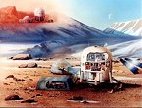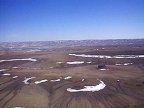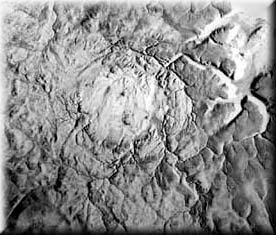Mars Arctic Research Station
A Mars Society Project



Haughton Crater, Devon Island, Nunavut, Canada
• Home Page
• Latest News
• Why Devon Island?
• Technical Specs
• '99 Reconnaissance
• Get Involved
• Weather
• The Team
• TF Members Login
• Mars Society
Have questions about this site? Contact Marc Boucher , Webmaster.
The Mars Society.
All rights reserved.
Some images
copyright © NASA
All rights reserved.
Dr. Pascal Lee, a NASA engineer who has lead three
expeditions to Devon Island in 1997, 1998 and 1999, and who is the MARS project leader, best
sums up the reason for selecting Devon Island, "By setting ourselves up
in this polar desert, we will experience an environment that most closely
resembles the surface of Mars."
Located approximately 75 degrees North, Devon Island forms a part
of the Queen Elizabeth Islands grouped between Baffin Bay and the
Arctic Ocean. Not only does the island exhibit geological and glacial
features which resemble features found on Mars, it's daytime
temperatures are similar to those of a "summer" day on Mars, and it is
largely snow and ice free in summer - some the Antarctic, another
popular Mars analogue, cannot offer so easily. While the atmosphere
may be 100 times as dense at the atmosphere on Mars is hardly an
issue. Everything else about the island makes it an ideal proving ground
for technology and equipment that may one day be carried to Mars.
Another consideration in using the island is that while it is remote, it is
still close enough to medical facilities to make evacuating anyone
suffering an injury or illness during the experiment relatively easily.

Radar image of Haughton Crater. Click on image for larger view.
What is the Haughton Crater?
The Haughton meteorite impact crater, on Devon Island, in the Canadian high arctic, is 20 km in diameter and formed 23 million years ago. It is the highest-latitude terrestrial impact crater known on land (75°22'N, 89°41'W). It lies in the "frost rubble zone" of the Earth, i.e., in a polar desert environment which approximates in several respects the conditions that may have prevailed at the surface of Mars earlier in it's history, when wetter and warmer conditions might have existed
By it's nature, the crater is a testimony to our planet's profound ties with the cosmos. By location, it represents a geographic extreme on our planet and, as it turns out, a unique analog to a neighboring world. Therefore, by studying the Haughton crater and it's surroundings, we hope to learn more about Mars, the Earth's geologic past, a cosmic phenomenon (impact cratering) that has in the past catastrophically altered the course of the Earth's evolution, and an extreme environment in one of the most rarely visited corners of our planet. While investigating Haughton, we will also learn how to best explore Mars, by testing robotic and human exploration technologies and strategies, and by optimizing interactions between the two.
So far, our initial reconnaissance of Haughton and its surroundings showed that a wide suite of natural features and processes occur there that provide possible analogs to similar martian features. These observations provide a basis for identifying similar features on Mars or, alternatively, for understanding why such features might be different there or altogether absent. Continued studies of Haughton will allow more detailed investigations of these martian analogs, and ultimately a better understanding of the evolution of Mars itself. The Haughton-Mars Project offers, in our view, a unique potential for broad-ranging science return and an opportunity for innovative engineering in geographic and planetary exploration. It is perhaps the combination of these factors that best defines the significance of the project.
Some images copyright © NASA. All rights reserved.